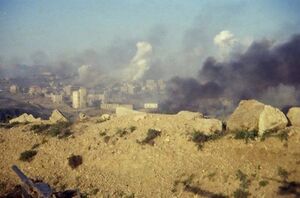Rice and Oil War
The Rice and Oil War (Quenminese: Chiến tranh Gạo và Dầu; Tamauese: สงครามข้าวและน้ำมัน: S̄ngkhrām k̄ĥāw læa n̂ảmạn) was a conflict in the Tyranian continent of Siduri that raged from 12 July 1991 to 18 August 1994. It was fought between Quenmin and Tamau against the amalgamation of rebel groups known as the Opposition Movement for the Permanent Independence of Tamau, also known as the FKPXT, and the Quenminese left-wing groups ARPAGHARCON and the AFWCQ.
On the Tamauite scope of the war, Origins of the conflict can be traced back to the Pagayabas Accords enabled deals between major Quenminese and Tamauite corporations to establish in Tamau oil facilities and farms help augment Tamau's economy after the Commodities Crisis of 1989. The Accords also promised to support the Archducal government in its war against two rebel factions, the Maneerattanaist Liberation Army and the Communist Party of Tamau, by shipping and distributing arms and ammunition. These were endorsed by both governments from Quenmin and Tamau. Apprehensions about the resurging Quenminese economic, and potentially political, influence over the country has lead to the Tamauite rebels to instigate attacks against Quenminese corporate employees and military suppliers; one of these involved the Nakhon Nayyao Attacks that targeted employees of the Quenminese company Green Marsh Alternatives and the Chan'ocha Investment Corporation in the early summer of 1991. Alongside this "declaration of war" was the formation of the 1288 Chayadaeng Remembrance Brigade and a central committee among the rebels known as the FKPXT.
The native Quenminese scope of the conflict was caused by the laws on increased military spending, lowering minimum wages, and suppression of labor unions implemented by the stratocratic government of Prime Minister Nguyễn-Thạch Sĩ Chiến. By proclaiming their revolutionary struggle and their advocacy of the FKPXT, the armed left-wing groups ARPAGHARCON and the AFWCQ provided arms and support to the Tamauite rebel consortium, and, aware of the illegality of this act, commenced attacks on Quenminese military bases in the Hue Tinh-Yên Tàu Incident. Sĩ Chiến's government implemented martial law throughout the Southern and Central provinces and deployed the military to quell the insurgency.
The war lasted for over three years with Quenmin and Tamau achieving a military victory. The FKPXT and the Quenminese left-wing forces inflicted a burdensome task upon the Quenminese and Tamauite armed forces through a mix of conventional and unconventional warfare. It was soon later overcome with the adaptability from the latter. Moreover, the conflict exemplified the utilization of UAVs in the battlefield. With surveillance footage from the air, the armed forces were able to commence reconnaissance missions without having to bear the loss of pilots. At the end of the way, the FKPXT and the Quenminese left-wingers surrendered.
The Chumlasin Accords was then signed by the Quenminese and Tamauite governments, which revoked the articles of the Pagayabas Accords. However, despite the victory for the greater good, this never meant that they were going to be let off easily by the public. On the Tamauite side, Archduke Viryacandra II soon abdicated the throne after public resentment over his involvement in the Pagayabas Accords intensified. It was then bestowed upon Kamalanan Jatusripitar, his son. In Quenmin, Sĩ Chiến's government and the POLMANATS party dealt with a loss of their political reputation after the Pagayabas Scandal. In 1993, it was then discovered in Quenmin that the Accords presented the opportunity for Quenmin to covertly control over half of Tamau's economic resources, particularly, rice and petroleum, under the proposal of a prospering Tamauite economy. Because of this, Quenminese opposition to the war later blossomed. Subsequently, Sĩ Chiến resigned his position as Prime Minister, and an election was called that resulted in the Yellow Dragon Party obtaining most seats in the government. The succeeding Prime Minister Lê Tấn Nguyên initiated a series of reforms that prevented the military from being closely involved in politics, as well as setting a standardized term duration for his office.
